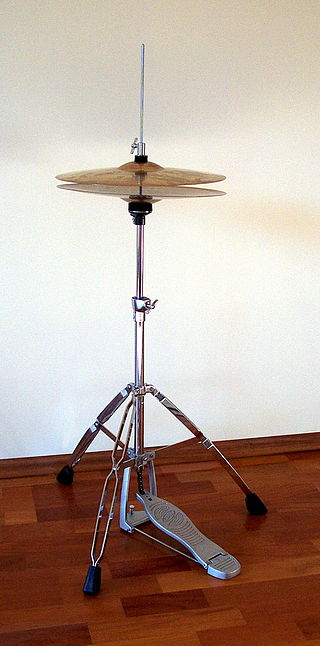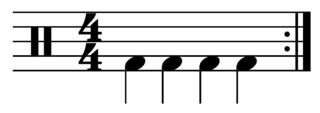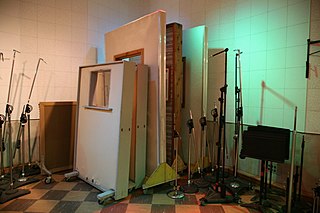
A drum kit is a collection of drums, cymbals, and sometimes other auxiliary percussion instruments set up to be played by one person. The drummer typically holds a pair of matching drumsticks, and uses their feet to operate hi-hat and bass drum pedals.

Funk is a music genre that originated in African-American communities in the mid-1960s when musicians created a rhythmic, danceable new form of music through a mixture of various music genres that were popular among African-Americans in the mid-20th century. It deemphasizes melody and chord progressions and focuses on a strong rhythmic groove of a bassline played by an electric bassist and a drum part played by a percussionist, often at slower tempos than other popular music. Funk typically consists of a complex percussive groove with rhythm instruments playing interlocking grooves that create a "hypnotic" and "danceable" feel. It uses the same richly colored extended chords found in bebop jazz, such as minor chords with added sevenths and elevenths, and dominant seventh chords with altered ninths and thirteenths.
Heavy metal is a genre of rock music that developed in the late 1960s and early 1970s, largely in the United Kingdom and United States. With roots in blues rock, psychedelic rock and acid rock, heavy metal bands developed a thick, monumental sound characterized by distorted guitars, extended guitar solos, emphatic beats and loudness.

A hi-hat is a combination of two cymbals and a pedal, all mounted on a metal stand. It is a part of the standard drum kit used by drummers in many styles of music including rock, pop, jazz, and blues. Hi-hats consist of a matching pair of small to medium-sized cymbals mounted on a stand, with the two cymbals facing each other. The bottom cymbal is fixed and the top is mounted on a rod which moves the top cymbal toward the bottom one when the pedal is depressed.

In music performances, rhythm guitar is a technique and role that performs a combination of two functions: to provide all or part of the rhythmic pulse in conjunction with other instruments from the rhythm section ; and to provide all or part of the harmony, i.e. the chords from a song's chord progression, where a chord is a group of notes played together. Therefore, the basic technique of rhythm guitar is to hold down a series of chords with the fretting hand while strumming or fingerpicking rhythmically with the other hand. More developed rhythm techniques include arpeggios, damping, riffs, chord solos, and complex strums.
Speed metal is an extreme subgenre of heavy metal music that originated in the late 1970s from new wave of British heavy metal (NWOBHM) roots. It is described by AllMusic as "extremely fast, abrasive, and technically demanding" music.

The bass drum is a large drum that produces a note of low definite or indefinite pitch. The instrument is typically cylindrical, with the drum's diameter much greater than the drum's depth, with a struck head at both ends of the cylinder. The heads may be made of calfskin or plastic and there is normally a means of adjusting the tension either by threaded taps or by strings. Bass drums are built in a variety of sizes, but size does not dictate the volume produced by the drum. The pitch and the sound can vary much with different sizes, but the size is also chosen based on convenience and aesthetics. Bass drums are percussion instruments and vary in size and are used in several musical genres. Three major types of bass drums can be distinguished.
The ride cymbal is a cymbal of material sustain used to maintain a beat in music. A standard in most drum kits, the ride's function is to maintain a steady pattern, sometimes called a ride pattern, rather than provide the accent of a crash cymbal. It is normally placed on the extreme right of a drum set, above the floor tom. It is often described as delivering a "shimmering" sound when struck soundly with a drumstick, and a clear ping when struck atop its bell.

In music, groove is the sense of an effect ("feel") of changing pattern in a propulsive rhythm or sense of "swing". In jazz, it can be felt as a quality of persistently repeated rhythmic units, created by the interaction of the music played by a band's rhythm section. Groove is a significant feature of popular music, and can be found in many genres, including salsa, rock, soul, funk, and fusion.
In jazz, comping is the chords, rhythms, and countermelodies that keyboard players, guitar players, or drummers use to support a musician's improvised solo or melody lines. It is also the action of accompanying, and the left-hand part of a solo pianist.

A rhythm section is a group of musicians within a music ensemble or band that provides the underlying rhythm, harmony and pulse of the accompaniment, providing a rhythmic and harmonic reference and "beat" for the rest of the band. The rhythm section is often contrasted with the roles of other musicians in the band, such as the lead guitarist or lead vocals whose primary job is to carry the melody.

Four-on-the-floor is a rhythm used primarily in dance genres such as disco and electronic dance music. It is a steady, uniformly accented beat in 4
4 time in which the bass drum is hit on every beat . This was popularized in the disco music of the 1970s and the term four-on-the-floor was widely used in that era, since the beat was played with the pedal-operated, drum-kit bass drum.
In music, a breakdown is a part of a song in which various instruments have solo parts (breaks). This may take the form of all instruments playing the verse together, and then several or all instruments individually repeating the verse as solo parts.
A drum beat or drum pattern is a rhythmic pattern, or repeated rhythm establishing the meter and groove through the pulse and subdivision, played on drum kits and other percussion instruments. As such a "beat" consists of multiple drum strokes occurring over multiple musical beats while the term "drum beat" may also refer to a single drum stroke which may occupy more or less time than the current pulse. Many drum beats define or are characteristic of specific music genres.

Jazz drumming is the art of playing percussion in jazz styles ranging from 1910s-style Dixieland jazz to 1970s-era jazz fusion and 1980s-era Latin jazz. The techniques and instrumentation of this type of performance have evolved over several periods, influenced by jazz at large and the individual drummers within it. Stylistically, this aspect of performance was shaped by its starting place, New Orleans, as well as numerous other regions of the world, including other parts of the United States, the Caribbean, and Africa.
In music, the term swing has two main uses. Colloquially, it is used to describe the propulsive quality or "feel" of a rhythm, especially when the music prompts a visceral response such as foot-tapping or head-nodding. This sense can also be called "groove".

This is a glossary of jazz and popular music terms that are likely to be encountered in printed popular music songbooks, fake books and vocal scores, big band scores, jazz, and rock concert reviews, and album liner notes. This glossary includes terms for musical instruments, playing or singing techniques, amplifiers, effects units, sound reinforcement equipment, and recording gear and techniques which are widely used in jazz and popular music. Most of the terms are in English, but in some cases, terms from other languages are encountered.

Spill is the occurrence in sound recording and live sound mixing whereby sound is picked up by a microphone from a source other than that which is intended. Spill is usually seen as a problem, and various steps are taken to avoid it or reduce it. In some styles of music, such as orchestral music, jazz, and blues, it is more likely to be accepted or even seen as desirable.

Heavy metal bass is the use of the bass guitar in the rock music genres of heavy metal and hard rock. The bassist is part of the rhythm section in a heavy metal band, along with the drummer, rhythm guitarist and, in some bands, a keyboard player. The prominent role of the bass is key to the metal sound, and the interplay of bass and distorted electric guitar is a central element of metal. The bass guitar provides the low-end sound crucial to making the music "heavy". The bass plays a crucial role in heavy metal and a more important role than in traditional rock."

Heavy metal guitar is the use of highly-amplified electric guitar in heavy metal. Heavy metal guitar playing is rooted in the guitar playing styles developed in 1960s-era blues rock and psychedelic rock, and folk harmonic traditions and it uses a massive sound, characterized by highly amplified distortion, extended guitar solos and overall loudness. The electric guitar and the sonic power that it projects through amplification has historically been the key element in heavy metal. The heavy metal guitar sound comes from a combined use of high volumes and heavy distortion.
















